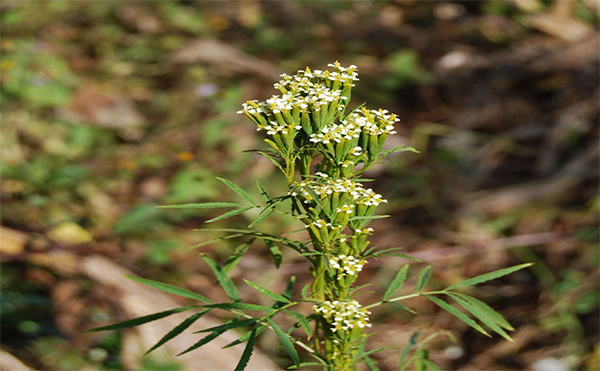Fact sheet about Tagetes minuta
Distribution and habitat
It is an invasive weed on farms. It grows well in disturbed areas and cultivated beds, usually found in on farms. Originally from South America but is now an exotic, widespread weed in Africa, South Europe, South Asia and Australia. In Kenya it is found in Nairobi, Taita Hills, Voi-Nairobi road, Kaimosi, Masai Mara, Kiambu, Nyeri, Embu and in Machakos.
Flowering and fruiting habits
It is a strongly scented annual herb with stiff erect stems up to 2 m tall. Leaves stalked, opposite, light green, up to 15 cm long, pinnately dissected into 4-6 pairs of pinnae. Leaflets lanceolate, margins finely serrate. Oil glands under leaves and on stems and involucres bracts. Inflorescences terminal with several tube-like capitula of dull yellow florets. Fruits, black achenes, narrowly ellipsoid and hard seeds, 6-7 mm long.
Uses other than pesticidal
Medicinal- It is used to treat gastritis, indigestion and intestinal worms. Externally it is used to treat skin infections and haemorrhoids. The essential oil treats fungal infections like athlete’s foot and boosts the respiratory system. It has antimicrobial, antiphlogistic, antiseptic, antispasmodic, cytophylactic, sedative, emollient, fungicide and hypertensive properties.
Other- It is used in perfumery and as flavour in beverages and the food industry.
Propagation and cultivation
Seeds germinate readily when sown fresh, without treatment. Seeds are sprinkled directly on soil or covered with soil. Germination takes place within one week. Seedlings can also be transplanted to pots. It grows well in disturbed areas, in heavy clay soils or sandy soils.
Seed collection & Storage
In Kenya, the seeds can be harvested in February, May and October. The fruits are sieved to remove the husks. One pod has several seeds.
Seed behaviour is orthodox. Viability of air-dried seeds can be maintained for several years in hermetic storage.
Parts used
Whole plant
Live roots
Preparation
Grind dried plants to produce powder
Plant extract
Essential oil
Boil leaves to produce a decoction
Secretions from live roots
Uses
Added to stored beans and maize
As a fumigant
Application
Ingested by livestock
Target organisms
Maize and bean weevils
Against aphid Brevicoryne brassicae and red spider mites in vegetables
Against ticks
Against intestinal parasites in domestic livestock
Against nematodes, worms, insects, fungi and perennial weeds

